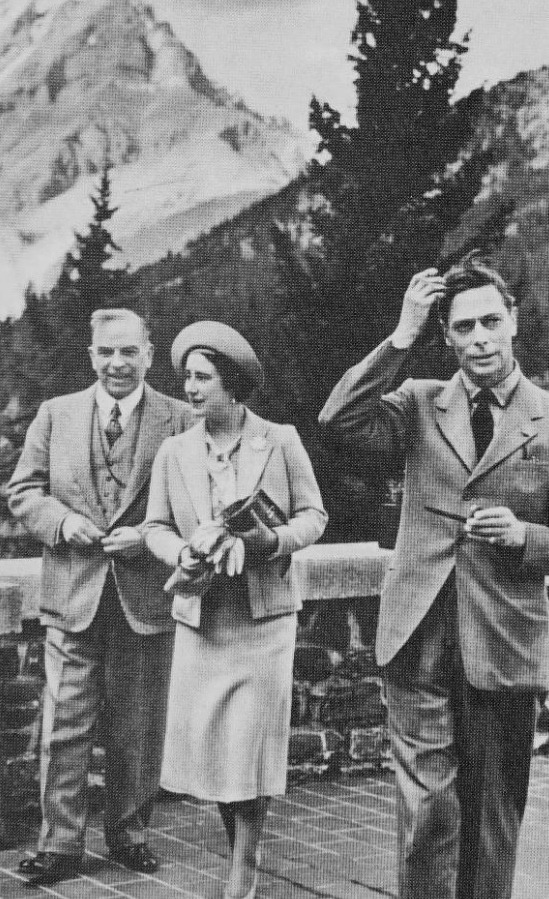#mackenzie king
Text

KING GEORGE VI and QUEEN ELIZABETH with Canadian Prime Minister MACKENZIE KING in Banff, Canada, 1939
What impressed me most when I found the King shaking my hand and looking at me was the blend of amiability and good sense in his face. It was a kindly and sincere face and also a face that looked very familiar. He has large blue eyes, a generous mouth and thick light brown hair, with a lock just above his forehead that has a way of blowing down over his eyes so that he has to push it back when he stands bareheaded in the open air as he so often does.
- Francis Stevens, Leader-Post reporter who met the King during the Canadian tour
75 notes
·
View notes
Text

King George VI and Mackenzie King (pictured at Buckingham Palace)
**************************
Reflecting on the American section of the trip, Mackenzie King assured the King it had surpassed all expectations…
“This trip has made a great deal to me, and a great deal to the Queen,” the King replied. He said it had been all about developing a “new idea of kingship” which was more in tune with the people and their interests – “no more the high-hat business, the kind of thing that my father and those of his day regarded as essential, as the correct attitude, that certain things could not be done, everything was to be just in such and such a way”…
Most revealing, though, were the insights the King gave into his attitudes to the throne. “When my father was alive, he filled an important place, was much before the public,” he told Mackenzie King. “My brother was equally prominent before the public. I was kept in the background. My father used to tell me I could never do anything because I could not speak.” Indeed, before George V’s death, when he could see the way things might go, he had gone to Sandringham with a view to telling his father he would not accept the throne – but never did so.
Quoted from “Hot Dogs and Cocktails” by Peter Conradi

#king george vi#favorite books#Peter Conradi#hot dogs & cocktails#you have a voice Bertie!#bertie & elizabeth#queen elizabeth#mackenzie king#Canada/USA 39#royal tour#british royal family
4 notes
·
View notes
Photo


1955.
The CBC suppressed a show about Mackenzie King, the former Prime Minister who often asked his taxidermied dog for political advice.
9 notes
·
View notes
Text

"Mary Churchill visits Canada," La Presse. August 11, 1943. Page 4.
---
The youngest daughter of the Prime Minister of Great Britain, Mary Churchill, accompanies her parents during their visit to Canada and currently in Quebec. She is seen in the top vignette, while attending a debutante ball at Grosvenor House in London. In addition, wearing her Territorial Service uniform, she attended the inspection of an infantry school in the north of England. On the right, like all the members of his unit. Mary does not disdain to do her own laundry.
#ville de québec#mary churchill#winston churchill#prime minister of the united kingdom#mackenzie king#mackenzie king government#prime minister of canada#canada in the british empire#quebec city#canada during world war 2#allied powers
1 note
·
View note
Text
In case you’ve missed it. Bombs Nora has dropped on AFTG Twitter in the last 48 hours:
- Katelyn’s last name is Mackenzie (and her role is being Aaron’s queen)
- Marissa’s last name is Baker and she used to be a Fox striker (how did this not come up before??)
- she has 1,584 files (84 folders) just filled with details about the characters and the plot of aftg (and she won’t let us see 😔)
- she said she didn’t give exact descriptions of the upperclassmen because they were meant to be mere personalities and the backbone of the fox line (however she did say she adores black Dan & Matt)
#aftg#all for the game#all for the game trilogy#andreil#andrew minyard#neil josten#the foxhole court#nora sakavic#the kings men#the raven king#kevin day#jeremy knox#jean moreau#jerejean#the sunshine court#tsc#katelyn mackenzie#psu foxes#aaron minyard
2K notes
·
View notes
Text

Katelyn being listed as Aaron’s queen has healed my soul in ways I cannot describe
#also MACKENZIE#THAT MEANS SHES FROM THE SAME CLAN AS ME#y’all don’t understand how that makes me feel#ROYALTY#aftg#all for the game#the foxhole court#the raven king#the kings men#katelyn#katelyn mackenzie#WE CAN USE THAT NOW#aaron minyard#nora sakavic
677 notes
·
View notes
Text
Aftg stupid ass dump!!



These were all done under 20 minutes.
That page is literally from my morning english class I wasn't paying attention to (it was done without a sketch, excuse the weird ass proportions).
I AM SO EXCITED ABOUT THE SUNSHINE COURTTT
I will draw real Jean and Jeremy content, whenever the fuck I can-
#aftg#all for the game#the foxhole court#the raven king#the kings men#neil josten#andrew minyard#aaron minyard#katelyn mackenzie#kateaaron#the sunshine court#jean moreau#jeremy knox#jerejean#that's way too many tags for a post like this hjdkqcgf#noah's aftg series
717 notes
·
View notes
Text










The ‘Monsters’
Instagram 1
#aaron minyard#andrew minyard#neil josten#nicky hemmick#kevin day#andreil#kevandreil#the monsters#all for the game#the foxhole court#foxhole court#the kings men#raven king#social media au#aftg au#katelyn mackenzie#erik klose
293 notes
·
View notes
Text
Katelyn posts a video of Aaron playing with the girls in their living room and captions it, “Watching my husband love our daughters because his world didn’t end at fifteen.”
#aaron minyard is the best dad#and he loves his girls how he wished his mom had loved him#he is the parent he needed#aaron minyard#katelyn mackenzie#aftg katelyn#aaron x katelyn#twinyardsx2#aftg#aftg hc#aftg headcanon#all for the game#the foxhole court#the kings men#the raven king#my aftg
206 notes
·
View notes
Text

#movies#polls#chunky shrapnel#2020s movies#john angus stewart#stu mackenzie#ambrose kenny smith#joey walker#king gizzard and the lizard wizard#requested#have you seen this movie poll
99 notes
·
View notes
Text
King Gizzard And The Lizard Wizard performing in dresses for pride night at the caverns 6/3/23




i am sooooo totally normal about this btw
#kglw#king gizzard and the lizard wizard#ambrose kenny smith#stu mackenzie#cavs#joey walker#look at em#bro look at stu#so fucking cute#AHHHHHHHHHHHHH
81 notes
·
View notes
Text

went to take my bins out and this absaloute fucking cunt wouldnt move his arse
140 notes
·
View notes
Text







recent sketchbook pages!!!
please excuse my horrible camera quality
#butterfly 3000#king gizzard & the lizard wizard#king gizzard fanart#my chemical romance#gerard way#furry art#furry#carseatheadrest#mortis jackrabbit#csh#jeff rosenstock#hellmode#stu mackenzie#1 trait danger
70 notes
·
View notes
Text

stu. your beautiful and strange dances have me bewitched
95 notes
·
View notes
Text
"King’s administration, however, had not shown any sign of bending much in the CPR’s direction. Indeed, his government implemented
Borden’s railway legislation, passing the Canadian National Railways
Act of 1919, and appointed an outstanding executive, Sir Henry Thornton, to the helm of the CNR in 1922. Thornton was a U.S.-born railway executive and engineer by background who had moved up the corporate hierarchy of the Pennsylvania Railroad before taking a general manager’s position with the Great Eastern Railway in England, at the time the world’s largest commuter system. After the outbreak of war, Thornton’s technical knowledge was drawn upon in the British war effort as he was cast into the role of inspector-general for the British Expeditionary Forces and made “responsible for operation of the whole intricate system upon which the existence of the British line depended.” Embracing advanced views on unions and labour relations, Thornton was respected by Great Eastern Railway employees and was a personal friend of J.H. Thomas, a major figure within Britain’s national railway union. It was Thomas who mentioned the CNR position to Thornton – a position that had opened up following the resignation of D.B. Hanna, who resigned in protest over “political interference” in CNR affairs exercised by the recently elected Liberal administration of Mackenzie King. Knighted for his war services, the affable
Thornton had gained a reputation as a railway “superman,” though his position with the Great Eastern had been extinguished after the government passed legislation to reorganize the British railway system. Thornton was quick to charm the Canadian public as well as CNR employees. Thornton “has quite won the hearts of all who have met him,” exclaimed Flavelle. More troubling to Flavelle and moderate progressives such as Dafoe, however, were Mackenzie King’s blatant political appointments to the CNR board. This was a departure from Borden’s ideal of nonpartisan, businesslike operation. Nonetheless, with Thornton at the helm, the CNR had behind it a power of incalculable importance: popular opinion.
Beatty was quick to see public relations as the most significant challenge facing the CPR. In 1923, encouraged by Beatty’s recent public pronouncements, Lord Atholstan commenced his “Whisper of Death” campaign in the Montreal Star, which forecast an oncoming deluge resulting from a mounting national debt, made intolerable by
costs associated with the CNR. Beatty considered Thornton nothing more than a “showman,” and sought to meet his challenge and correct “political misrepresentation” about the railways through an institutional advertising campaign. (Thornton, for his part, considered Beatty “a lawyer [and] not a railway man.” ) Indicative of this public relations drive, Dafoe reported in the summer of 1925 that
“unfair competition invariably comes up” in discussions with high CPR officials; “[t]hey hope for the Shaughnessy plan or a merger.” In April, Clifford Sifton reported: “I do not think the Canadian Pacific has ever been as active in propaganda as it is now. Their intrigues and efforts to influence official opinion are in evidence everywhere.” Sifton asked Dafoe to have the Winnipeg Free Press “declare war on the scheme and fight it out.”
This drive had its effect in Ottawa, where a Senate committee was established to investigate the railway question in 1925. At the committee’s closed-door hearings, Beatty and Sir Herbert Holt presented cases for railway amalgamation so similar that a summary of the proceedings described their presentations as one position. The Senate proved particularly responsive to CPR influence, and the committee’s report presented an opinion generally in line with Beatty’s case, which Beatty himself would reference in arguing for railway unification in the future. Beatty and Holt, as we have seen, met with King the same summer to discuss railway policy, and Beatty continued to press King to leave the door open for railway unification later in the year. But the political bagmen who inhabited the Senate found it easier to embrace railway consolidation than the MPs who counted on popular support in their constituencies.
This was somewhat stifling to the aspirations of Beatty and his moneyed allies. With neither major political party embracing his position on the railway question, Beatty remained “neutral” in the 1926 federal election, preferring to support favoured individuals in both major parties. While Beatty finessed his way around Ottawa, much of the railway battle was being waged in direct business competition, made more lucrative by the boom at the end of the 1920s as the two companies engaged in competition through line extensions, hotel construction, expansion of shipping fleets, and improvements in commuter services. While Beatty advocated consolidation of the two competing systems under private ownership, economic expansion during the 1920s made competition a viable option. Indeed, Beatty reported that $353,346,450 in dividend payments were distributed to common and preferred shareholders during the period from 1918 to 1930, representing 85 per cent of the company’s total earnings “after deducting fixed charges and pension fund appropriations.”
Thornton, meanwhile, modernized the CNR and emerged as a national icon of sorts, emblematic of the possibilities of public enterprise and cooperation between the state, capital, and labour, culminating in Thornton’s address at the American Federation of Labor’s international convention in 1929 in Toronto, where Thornton proclaimed the beginning of “a new labor era.” The “very particular conjunctures of context, character, and circumstance” that underpinned Thornton’s rise, as Allen Seager has observed, disintegrated with the arrival of the Great Depression. Thornton would be one of its first and most public victims, a public sacrifice encouraged by Beatty as he moved even deeper into political activism.
The Duff Commission and “the Tragedy of Henry Thornton”
Meighen, Roger Graham has written, “was not spared the intrigues of
the Montreal tycoons” as talk that R.B. Bennett would be his successor emerged in early 1926; Bennett was “known to hold more ‘businesslike’ opinions about railway matters” than Meighen, whom Bennett once famously described as “the gramophone of Mackenzie and Mann.” Bennett’s election as leader of the Conservative Party in 1927 was an encouraging sign and a small victory for Beatty and St James Street. They respected the independently wealthy Bennett, believing him to be above petty politics; they shared his deep sense of loyalty to the British Empire; and they felt assured about his protectionist tariff policies. “St. James Street favours Bennett because of his protectionist policies,” wrote Prime Minister King pessimistically before the 1930 election. King also learned that “Beatty was favourable to Bennett’s views.” The list of Montreal donors to Bennett’s campaign, observed historian Larry Glassford, “read like a Who’s Who of the Montreal financial and industrial establishment.”
Formerly the chief western solicitor of the CPR and a major shareholder in the Royal Bank, Bennett’s immersion in business and his history with the CPR certainly helped to make him a more reliable candidate for wealthy Montreal residents – but on the campaign trail such connections were a potential liability. With his proclamation “Amalgamation never, competition ever” in a campaign speech, Bennett sounded publicly his independence from Beatty in an attempt to assure western voters that he would not cede a railway monopoly to the CPR. Popular appeal again seemed to trump Beatty’s long-term goals. The seeds of future conflict between Bennett and Beatty were planted even before the electoral triumph of the Bennett Conservatives in 1930.
Canada had more railway mileage per capita than any other nation
by the 1930s. The financial strain of maintaining two competing national lines had seemingly resolved itself during the boom years of
the late 1920s, only to reemerge as a sudden crisis once the economic slump set in. The financial position of the CPR worsened: in the first half of 1931, the CPR reduced dividend payments and soon after suspended payments altogether. Worse still was the position of the CNR, which was already weighed down by an unwieldy capital structure that included old debts accumulated by Mackenzie and Mann and the Grand Trunk. Company earnings fell by $46,249,000, and Thornton attempted cost-cutting measures without implementing wholesale layoffs.
Philosophically opposed to public enterprise, Bennett viewed Thornton as a creature of the King government; and he supported a campaign that conflated Thornton’s lavish private lifestyle with his management of the CNR. While in London, England, in October 1930, Prime Minister Bennett wrote his minister of railways and canals, R.J. Manion, about the shopping activities of Thornton’s wife:
President’s wife here purchasing furniture. President cabled her improvements would cost eighteen thousand dollars and she must spend less for furniture. She says building requires improvements. Whatever action you take entirely satisfactory. I was only desirous [to] communicate casual information.
The CNR directors had approved funds for Lady Thornton to furnish
their Pine Avenue home “in a manner appropriate for the residence of
a president.” But, having received this “casual information” from Bennett, Manion reneged on the agreement. Thereupon Sir Henry perceived that “a concerted plot to ruin his personal reputation” was in the works. He pressed Manion in December to honour the agreement that $20,000 in CNR funds be made available for renovations to his house, explaining that he was “very hard up, stock losses, etc.” Manion did not bend and described his reply to Bennett:
I told him that if the case came up in the House I wanted to be able to say that we had nothing to do with the matter – that the whole arrangement had been made under the previous administration.
Thornton would serve as a sacrificial lamb for the supposed improprieties of the King administration.
The following year the Railway Committee of the House of Commons provided new opportunities to undermine Thornton’s public reputation and associate him with the supposedly spendthrift ways of the Liberals. Manion, R.B. Hanson of New Brunswick, and Dr Peter McGibbon, MP for Muskoka-Ontario, were among the most active Conservative members to tar Thornton in the House, citing imprudent company expenditures on hotels, suggesting (falsely) exorbitant company salaries, and drawing attention to Thornton’s salary and personal expense account. Though Beatty admitted the unfairness of some of the attacks levelled against Thornton, he also recognized new political opportunities on the horizon.
Upon Beatty’s suggestion, a beleaguered Thornton called for the
formation of a royal commission to study the railway question. And though Beatty and Holt complained about delays in getting the commission established, the Duff Commission was finally formed in November. Before the commencement of the commission’s hearings, Beatty was “very hopeful that something constructive” could be achieved and lauded its personnel as “really outstanding.” Chaired by Supreme Court Judge Lyman Duff, the commission included six other prominent figures with weighty business – and some academic – credentials: Joseph Flavelle; Beaudry Leman of Montreal, general manager of the Banque Canadienne Nationale and president of the Canadian Bankers’ Association; U.S. railway executive Leonor Fresnel Loree, president of the Delaware and Hudson Railway Company; Lord Ashfield, head of London’s underground system, the Metropolitan Railways; Walter Charles Murray, president of the University of Saskatchewan; and the Shediac, New Brunswick, physician John Clarence Webster, a respected Conservative, museum patron, and personal friend of Howard P. Robinson.
From his office in Winnipeg, Dafoe reflected upon the significance of the commission’s establishment. “Perhaps I am getting too suspicious in my old age,” he wrote Free Press correspondent John A. Stevenson
but I have a most decided ‘hunch’ that this Commission was appointed to do a particular chore, and that with perhaps two exceptions its members know what the chore is to be. I think the linked money powers in Canada and the United States, with all their subordinate and associate interests, have decided that the time is opportune to oblige Canada to remove her desire to own and operate her own railways.
Dafoe believed that – as part of this plot to gut the CNR – the same tactic deployed in England to dislodge the Labour government might be deployed in Canada: “National Government.”
Had Dafoe become “too suspicious” in old age? Not entirely. The
ever-domineering Bennett had taken a personal interest in the formation of the commission and appeared to be in closer contact with St James Street than the responsible minister, Manion. Winnipeg Free Press correspondent Grant Dexter reported on 15 November that Manion was in “complete ignorance” about the commission’s personnel, but two weeks earlier a private memorandum written by Floyd Chalmers of the Financial Post revealed that Sir Herbert Holt was up to date on recent developments in the selection of commission personnel. “I want to take back anything about believing that amalgamation is off,”
wrote Dexter.
Meanwhile, Thornton’s experience at the hands of the Conservatives had led him to an about-face: in a meeting with Dafoe at Winnipeg’s Fort Garry Hotel on 12 October, Thornton lamented that he had lost faith in the ideal of public enterprise – the CNR, in the interest of its own survival, would have to come under the control of some form of unified management along with the CPR. He told Dafoe that he and Beatty had been working on such a plan together, a fact later confirmed by Lady Thornton. After Thornton’s death, his biographer, D’Arcy Marsh, would write (in 1934) that Thornton had been made “constitutionally incapable” of opposing Beatty, and Dexter believed that Thornton had sold out to Beatty to save his job. Dafoe, Marsh, and Dexter were overly cynical in assessing Thornton’s actions. And though Dafoe’s suspicions had some basis, he greatly exaggerated the level of coordination between Bennett and Beatty.
The proceedings of the Duff Commission commenced on 4 December 1931 with the commissioners interviewing Sir Henry Thornton in a session closed to the public – as was the testimony of all senior railway and government officials. Thornton proposed the establishment of a ten-person “superboard,” consisting of the presidents of each railway company, two Liberal, two Conservative, and two Progressive representatives, a representative of labour, and a representative of the minister of railways and canals. Though Dafoe and others, not privy to his testimony at the time, might have considered it something of a sellout, such judgments are overly harsh. Thornton believed the board, which would oversee both railways and enforce cooperation, would be able to conciliate various interest groups, and his plan thus attempted to establish a mechanism whereby a form of democratic control over the management of the country’s railways would obtain.
It was Thornton’s embrace of the principle of democratic control that set him apart from Beatty – and here Thornton was steadfast. The very goal of exercising democratic control over Canada’s railway systems was thought dubious by commission members, however. Commissioner Loree asked CNR vice-president S.J. Hungerford whether “it be a fair statement to make that a democratic form of government is no competent agency to carry on the railroad business?” To Hungerford’s assertion that “[w]e are seeking to do it,” Loree replied: “But are they doing it? The records do not show they are, because they are going behind every year.”
With the questioning at times threatening to transgress the line of
gentlemanly decorum, Thornton stressed that management of the CNR was a matter of public policy and thus did not necessarily need to justify itself on the basis of profits and losses. In response to a statement by Joseph Flavelle that such an enterprise should not be maintained, Thornton asserted that it was “a matter for the Canadian people to decide.” Beatty appeared before the commission the next day and presented a case that was ideologically much easier for the commissioners to appreciate.
If, on one hand, the privately owned system finds it is unable to maintain its credit in an unequal struggle with the long purse of the state,” Beatty said before the commission, “a grave injustice will be done to the shareholders of a corporation which has fulfilled its fifty-year old contract with the nation, and which has made its full contribution to the upbuilding [ sic ] of the Dominion. Such a consummation would cause most serious injury to the reputation of this young country as a field for private capital.
The cases of Beatty and Thornton differed at a fundamental level, centring not only on the appropriate role of the state in the nation’s economic life but on the appropriate role of public opinion in shaping economic policy. Beatty opposed government intervention, except in a helping role to private capital – steamship subsidies and protective tariffs, for example (which the CPR benefited from). He was also generally dismissive of popular opinion. Thornton, he believed, had succeeded by “showmanship” and “mob appeals.” The deluded public, in Beatty’s estimation, deserved only a very limited role in deciding public policy, and, as we shall see, he turned to “educational” work to address this issue. Thornton, by contrast, accepted some degree of “political” interference in economic affairs as inevitable under any democratic government. “After all in any form of popular government it must be accepted as axiomatic that the business of government is politics and,” Thornton stated before the commission on 4 January 1932, “irrespective of whether one likes it or not, politics is something with which a government must reckon in all its activities.”
Though commission members disliked the idea of public influence over railway management, a view that would be plainly expressed in their report, they were at least equally concerned with the prospect
of leaving the nation’s railways in the hands of a private monopoly.
Beatty proposed a “unification” plan of the two systems under CPR
management that would maintain separate ownership: CPR personnel would act as trustees of the government’s property. Commissioners Flavelle and Loree expressed concern over the de facto monopoly that Beatty’s plan would create. (Beatty privately dismissed Flavelle’s business philosophy, which stressed the role of competition, as “the Flavelle school of ruthless business brutality.” ) Commissioner Webster was somewhat less worried about monopoly.
“The fear of monopoly did not terrify me, as it so strongly impressed Sir Joseph,” he wrote to Meighen in November 1932, “nor did I shrink from submitting the responsibility of conducting so great an undertaking to a single management.” Beatty did not try to hide the monopoly implications of his plan but rather defended the principle of monopoly itself, arguing that “some of the most efficient, most widely administered and most publicspirited public corporations on this continent are monopolies.” “They are in the main,” he continued, “successful, efficient and progressive, and they are administered by men of high character and great ability.” For Beatty, who believed business enterprise to be a form of public service, the most important factor was the quality of business leadership. Since management would be composed of “business statesmen of the highest type,” he did not believe the “question of autocracy” could arise.
Beatty appeared before the commission again on 19 February and
presented a memorandum outlining the benefits of unification, in which he reiterated the need to impose businesslike management over the country’s railways. Asked by commissioner Loree whether a board of directors consisting of CPR and government representatives might successfully manage a unified system, Beatty foresaw two problems. First, the government would be exercising too much active influence in railway matters; second, government involvement would render “doubtful the type [of individuals] that would be selected for appointment to the Board.” Such an arrangement could only be successful if independence from the government were established; Beatty suggested an independent tribunal might select government representatives from “the Canadian Bankers Association, the Canadian Chamber of Commerce and a Judge of the Supreme Court” and be “certain to get the type of men whose ability would justify the selection.”
Beatty’s formulations were latently elitist and antidemocratic: “quality” leadership was presumed to reside in the upper echelons of the business community, and management of the railway system could not be entrusted to any other segment of the population – indeed, it was necessary to insulate such leadership from the pressures of popular opinion. According to Beatty’s beliefs, efficient
railway policy required that it not be formulated outside the meritocratic order that decided success or failure in private enterprise; “political” interference was unacceptable. Beatty was not unique in this mindset; the commission’s report echoed similar sentiments.
The commission’s proceedings prefaced Thornton’s final fall from grace in public life. Thornton had been divorced and quickly remarried (to a much younger woman) several years earlier, and he was known to enjoy nightlife. These were not important problems while the CNR was operating at a profit, but once that changed, Thornton’s personal life was conflated with his management style to devastating effect. He managed the railway the way he lived, his detractors claimed. Called once again before the House of Commons to testify, the gentlemanly decorum of the commission hearings evaporated, Thornton was subjected to a verbal assault by R.B. Hanson. Thornton’s public tarring eroded his political support in the House of Commons. Teetotaller, opposition leader, and political acrobat Mackenzie King acquiesced to this portrayal of Thornton, writing in his diary: “The truth is Thornton has not measured up of late, has drunk too much – far too self-indulgent.” Thornton would later write to King that he had departed from Ottawa under the auspices of a “reign of terror,” “always ‘shadowed’ by a detective.” “The Canadian Pacific Ry. has … exercised a sinister influence in Canadian politics – It has never hesitated at bribing + corruption in all its forms and it represents the worst type of predatory capitalism,” Thornton wrote to King the following day. “It has ruined men.” Undoubtedly, Thornton counted himself among the “ruined men”: “I feel fairly certain I might have remained where I was had I cared to go along with Beatty.”
- Don Nerbas, Dominion of Capital: The Politics of Big Business and the Crisis of the Canadian Bourgeoisie, 1914-1947. University of Toronto Press, 2013. p. 125-133.
#canadian pacific railways#canadian national railways#railway construction#track laying#train stations#railway capitalism#great depression in canada#the pressures of the great depression#capitalism in crisis#capitalism in canada#railway company#royal commission#canadian politics#canadian elite#canadian history#dominion of capital#mackenzie king#r. b. bennett
0 notes
